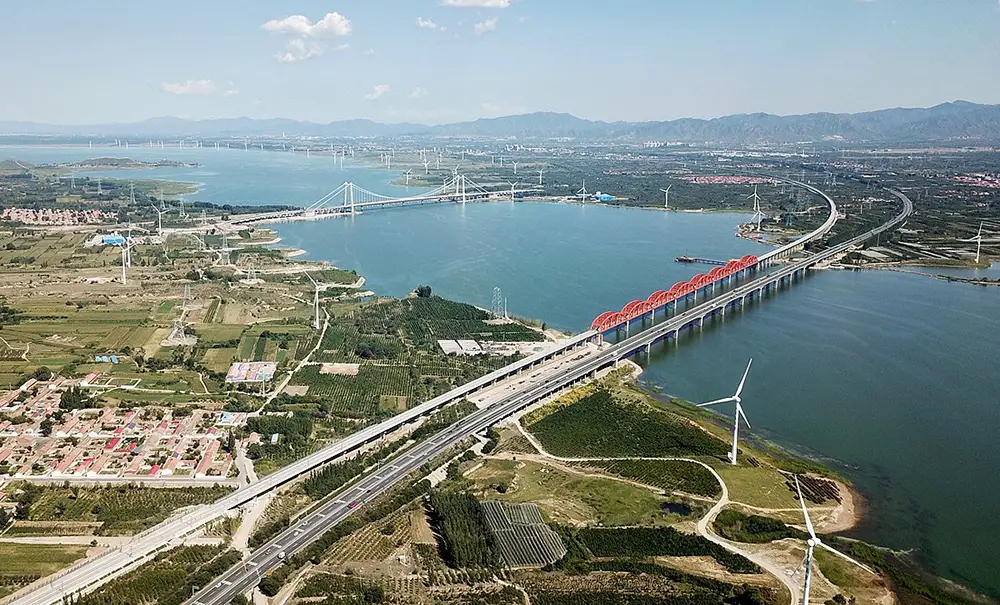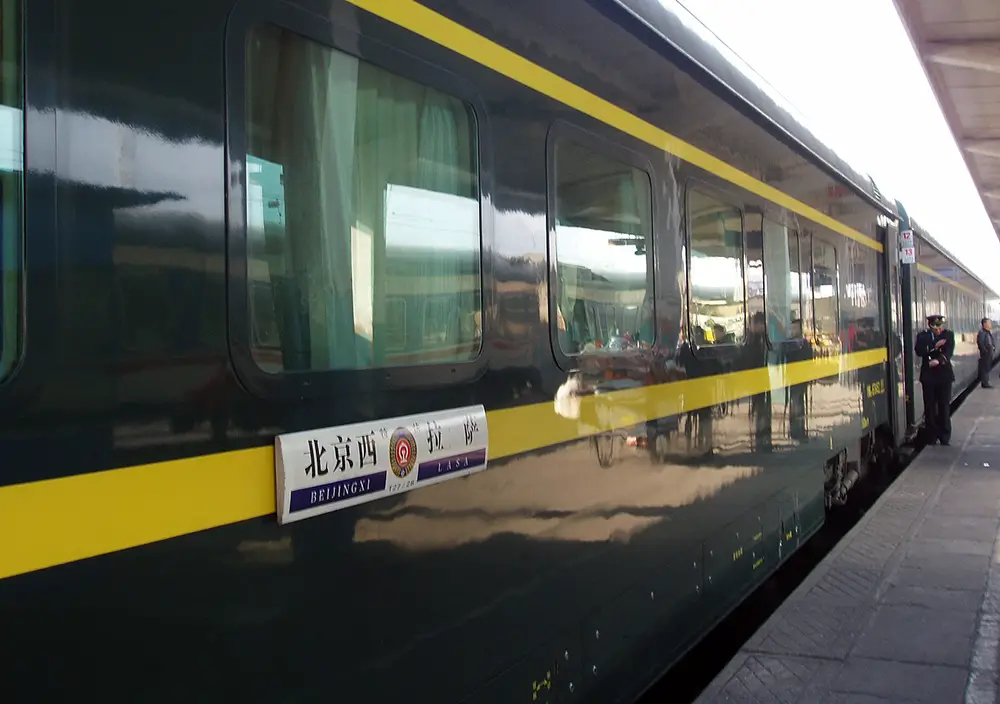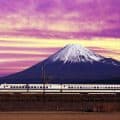China has one of the biggest railway networks in the world and the government is building even more. Maybe the most scenic railway journey you can take in China is on the Beijing-Lhasa Railway. For the people who want to be able to view the Chinese countryside as never before, this train trip is a must. With the ability to have quicker and more affordable transport to and from the Chinese capital, this destination has given a breath of fresh air to travellers and train enthusiasts alike.
Here are 25 Amazing Facts about the Beijing-Lhasa Railway:
Photo source: Wikimedia Commons
#1 – This railway was actually the first railway Tibet has ever had, beforehand they had to make do with cars, horses or carts to make their way to the rest of Mainland China. This is no longer a problem for the people of Tibet, what a life-changing improvement to their public transportation.
#2 – The railway from Beijing to Lhasa is incredibly long; the track’s exact length is reported to be 3,757km. If you want help visualizing just how big this truly is, this would make it about 86% the length of the continental United States of America.
#3 – This is the highest railway in the world, with its highest point being almost 16,500 feet above sea level. This beat the previous record by almost 700 feet, which was set in the Peruvian Andes.
#4 – Taking the train from Beijing to Lhasa may be the fastest form of public transport available, but it still takes quite a while. If you choose to do the trip non-stop, it will take somewhere around 40 hours and 45 minutes (40:45).
#5 – If you are looking for a good way to see the different variations of the provinces China has to offer, this is a great way to do so. This railway passes through eight different provinces between Beijing and Lhasa. It is a completely unique way to see the Chinese countryside and mountain areas, as there are just a few big connecting roads. In many of the more remote sections, places are largely uninhabited.
#6 – Another record that the Beijing-Lhasa Railway holds is that of having the longest distance of the track built on frozen ground. Not quite built on a glacier, but built on almost permanently frozen earth! This distance is 550 kilometers, which is no small feat of engineering. Building on the frozen ground comes with its own difficulties and complications.
#7 – Over 100,000 workers contributed to the construction of this railway, from all different regions and ethnic backgrounds. It is one of the largest multicultural engineering projects in history and will likely remain that way for a long time. Coordinating such a large number of people to commit to a common goal is incredibly difficult and the fact the Chinese managed to do this so quickly and successfully is very impressive.
#8 – Although there were so many workers assigned to this project, and they were at such a high altitude, no one died of altitude sickness. Before the project began, altitude sickness was a real concern for project managers and architectural engineers. The fact they had no deaths from this factor is an absolute miracle.
#9 – A famous American writer and traveler, Paul Theroux, once stated in the late 20th century, that there could never be a mountainous railway from Tibet, that building one through all the mountains would be an impossible task. At the very beginning of the next century, the railway opened in 2006. Paul Theroux underestimated the resolve of the Chinese to get this project done.
Photo source: Wikimedia Commons
#10 – The highest train station in the world lies on this track. On Mount Tanggula, Tanggula Station resides at 5km above sea level. As mentioned above, much of the track is built at this height so it only makes sense that there should be a station up there too. The views from this station must be absolutely spectacular.
#11 – Although the train journey can take about 40 hours on average from one end to the other, it is possible to do the journey much faster. If you have the money, you can take the higher-speed train which will only take 21-22 hours. Being able to go double the speed will be well worth the money, unless you prefer life in the slow lane.
#12 – If you need to make the journey and aren’t interested in the price or the sights, the soft sleeper train is also available. You will be able to sleep away half the journey and spend the other half in relative comfort. This is much more preferable to the other extreme which is the hard seat of the slow train, which takes almost 53 hours at most. Even the biggest train enthusiasts may give this one a miss.
#13 – This journey boasts 89 stations, which when compared to railways such as the Trans-Siberian Railway (which is many times longer and has only about 120 stations), becomes even more impressive. The Beijing-Lhasa Railway was designed to be as easily accessible to as many people across its length as possible.
#14 – The world’s highest tunnel also belongs to this railway. Sitting at almost 5km above sea level, this tunnel is both the highest tunnel built on frozen earth and the highest tunnel overall. This tunnel is called the Fenghuoshan Tunnel.
Enjoy this video of an amazing journey though China:
Video Credit: We’re the Russos – Click Here to watch directly on YouTube
#15 – The Chinese government began assessing and planning for the railway as far as 50 years (1956) before it was finally opened. So much attention to detail and careful planning contributed to making this railway the monumental success that it is today.
#16 – The whole project cost approximately 216 billion Yuan, which is about $32 billion US dollars. This was a huge financial undertaking and one that has already begun to pay itself off massively. The railway needed to be completed to access Tibet and its surrounding provinces, so it was built no matter the cost.
#17 – Another claim to fame of the Beijing-Lhasa Railway is that it has the longest plateau tunnel in the world, which is about 1,680m long. This tunnel is known as the Kunlun Mountain Tunnel. Building a tunnel at such a high altitude and such a great length is very impressive, and many people were skeptical thought such an ambitious railway project was ever going to happen.
#18 – Although the railway was completed and opened to the public in 2006, it actually has still been developed and expanded slightly as recently as 2015. New branch lines and stations were needed and were thus added. As the population of China grows, so must this railway line. The Chinese government already has more plans for expansion over the next few decades.
#19 – The record for the world’s longest railway bridge on a plateau also belongs to this railway. It’s the Qingshui River bridge which is about 11.7km long and 4,000 m high. This bridge is also built on the frozen earth making its achievement even more impressive.
#20 – A common fear around the world was that building through this previously underdeveloped area could cause damage to the local fauna and flora. With this in mind, 33 wildlife channels for local animal immigration were created to minimize the environmental impact.
Map source: Tour Travel Tibet
#21 – The Beijing-Lhasa Railway holds the record for the fastest train over frozen earth. The track is designed to accommodate speeds of up to 100km per hour within the frozen sections of the track. In the non-frozen ones, 120km per hour is the norm.
#22 – If you are a big animal lover, this railway has a real treat in store for you. All along the Tibetan side of the railway, you will be able to see the beautiful Tibetan yaks. These yaks have been able to not just survive but continue to thrive using the animal immigration paths that were created. And it is not just the yaks, the Tibetan antelopes population has also increased to almost 200,00 strong.
#23 – Because the railway is so famously high, it does come with some complications. The carriages are all fitted with oxygen supply systems for both safety and comfort when traveling at the highest altitudes. If this is still a concern for you, there are also doctors and other trained medical professionals on board just in case. Hopefully, if you plan to travel this way, you now have some peace of mind.
#24 – In 2016, on the railway’s 10th anniversary of the date it opened, the railway transported 115 billion people and 448 billion tons of cargo. Just to help you understand just how many passengers that is, that is as if every single human being on earth used that train 16 times in 2016. This absolutely shows just how needed this railway really to connect Beijing to Tibet and its surrounding provinces.
#25 – Despite everything it has done right, the average temperature in the plateau areas has increased by almost 2 degrees Celsius over the last few decades. The global average has grown too, but not by this much. You could argue that this is the cost of progress, but it is still something to keep in mind. Some steps have been taken to be more environmentally conscious along this railway, but many people globally are demanding that more be done.
The Beijing-Lhasa Railway is truly a huge step forward for the people of China and most importantly for accessing Tibet. It may not be as flashy as some of the other famous railways but it would still make a truly enjoyable journey. Being able to take in such a wide selection of scenery, see some unique wildlife, and travel through high mountains is a true treat for rail enthusiasts and travelers alike.
You might also like the following facts about the best railway journeys in the world:
- 25 Amazing Facts About the Euro Rail & Eurail
- 25 Amazing Facts About the Shinkansen, the Japanese Bullet Train
- 25 Amazing Facts About the Thai-Burma Railway
- 25 Amazing Facts About the Amtrak Railway
- 25 Amazing Facts About the Orient Express
- 25 Amazing Facts About the Bangkok-Ayutthaya Railway
- 25 Amazing Facts About the Trans-Mongolian Railway








